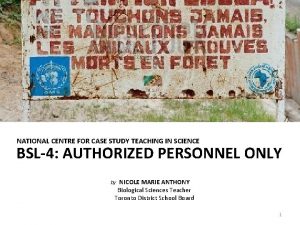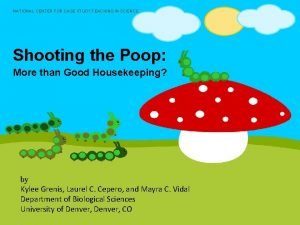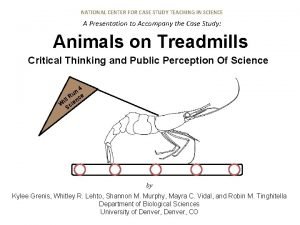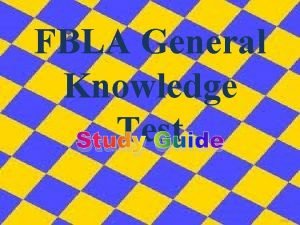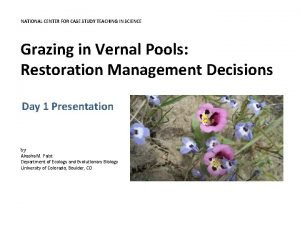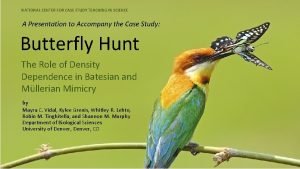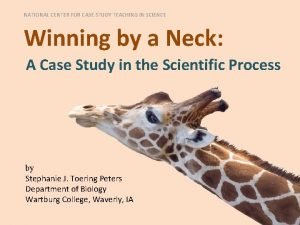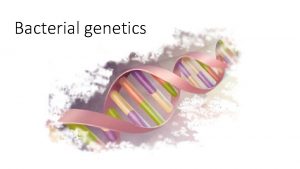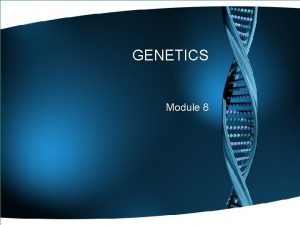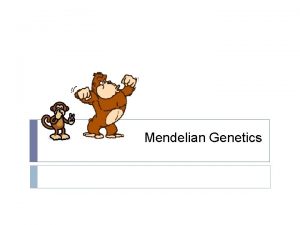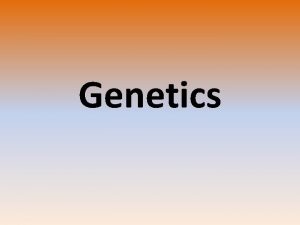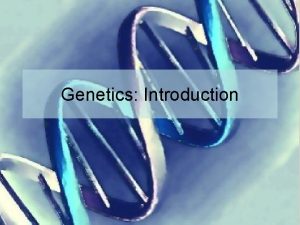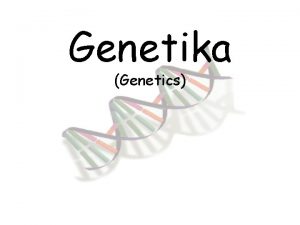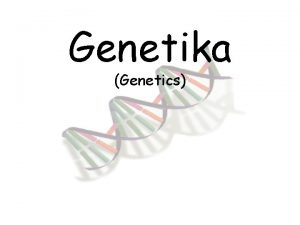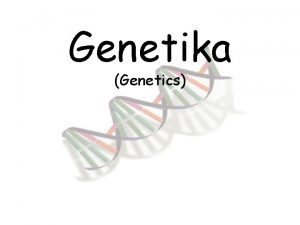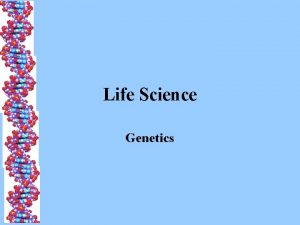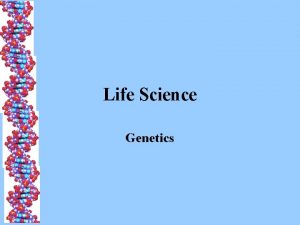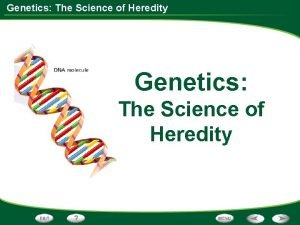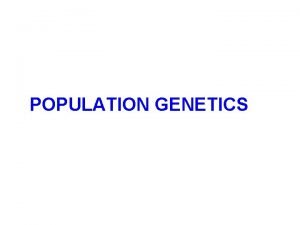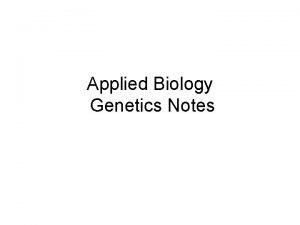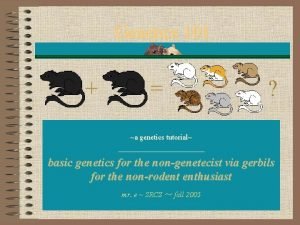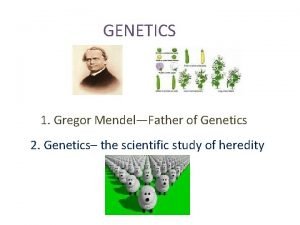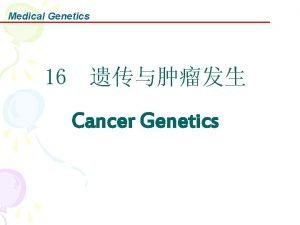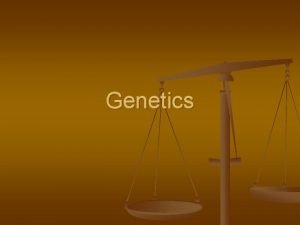Genetics What is the study of Genetics Science









































































- Slides: 73

Genetics

What is the study of Genetics? • Science of heredity or the passing on of traits from one generation to the next • Study of genes and their transmission to new generations

Gregor Mendel • Student in early 1800’s who studied math and science 1 • Tended the gardens in a monastery • Worked with pea plants to study how traits are passed down from one generation to the next

Why Pea Plants? • True-breeders if self-pollinated, they give rise to identical plants/offspring (also called pure-breds) • Easy to control breeding through crosspollination • Give many offspring so results were more statistically sound

Heads or Tails? • Flip a coin 20 times. • How many times landed heads? Tails? • Add up class results. How many times landed heads? Tails? • Why are the class statistics more sound than those of each individual?

Mendel’s Experiments • Used cross-pollination to make 7 crosses • Tested 7 genes where each gene had 2 variations each • Therefore he obtained 14 different pure-breds

Cross-fertilization

Mendel’s Crosses Seed Shape Seed Color Round Yellow Wrinkled Green Seed Coat Color Gray White Pod Shape Pod Color Smooth Green Constricted Yellow Flower Position Plant Height Axial Tall Terminal Short

Results from Mendel’s 1 st Crosses Seed Shape Seed Color Round Yellow Seed Coat Color Gray Pod Shape Pod Color Flower Position Smooth Green Axial Tall Short Wrinkled Green White Constricted Yellow Terminal Round Yellow Gray Smooth Green Axial Plant Height Tall

Menel’s Results

Mendelian Vocabulary • P (parental generation) • F 1 – first filial generation – the offspring resulting from a cross between the parents from the P generation • F 2 – 2 nd filial generation – the offspring resulting from a cross between the F 1 generation • Hybrids – the offspring of crosses between parents with different alleles/traits

Experiment P Generation (true-breeding parents) Purple flowers White flowers

Experiment P Generation (true-breeding parents) Purple flowers White flowers F 1 Generation (hybrids) All plants had purple flowers Self- or cross-pollination

Experiment P Generation (true-breeding parents) Purple flowers White flowers F 1 Generation (hybrids) All plants had purple flowers Self- or cross-pollination F 2 Generation 705 purple-flowered plants 224 white-flowered plants

Allele for purple flowers Locus for flower-color gene Allele for white flowers Pair of homologous chromosomes

P Generation Appearance: Genetic makeup: Gametes: Purple flowers PP White flowers pp P p

Figure 11. 5 -2 P Generation Appearance: Genetic makeup: Gametes: Purple flowers PP White flowers pp P p F 1 Generation Appearance: Genetic makeup: Gametes: Purple flowers Pp ½ P ½ p

Figure 11. 5 -3 P Generation Appearance: Genetic makeup: Purple flowers PP White flowers pp P p Gametes: F 1 Generation Appearance: Genetic makeup: Gametes: Purple flowers Pp ½ P Sperm from F 1 (Pp) plant F 2 Generation Eggs from F 1 (Pp) plant P p PP Pp Pp pp P p 3 : 1

Phenotype 3 Genotype Purple PP (homozygous) Purple Pp (heterozygous) 1 2 1 Purple Pp (heterozygous) White pp (homozygous) Ratio 3: 1 Ratio 1: 2: 1 1

How can you tell whether something displaying a dominant phenotype is homozygous or heterozygous?

Technique Test Cross/Back Cross Dominant phenotype, unknown genotype: PP or Pp? Recessive phenotype, known genotype: pp Predictions If purple-flowered parent is PP Sperm p p If purple-flowered parent is Pp Sperm p p or P P Pp Eggs P Pp Pp pp pp p Pp Results Pp or All offspring purple ½ offspring purple and ½ offspring white

Table 11. 1

First Conclusions • Biological inheritance is determined by « factors » that are passed from one generation to the next. Today we call these factors « Genes » • Each of the 7 traits Mendel studied were governed by only one gene and each gene had 2 possible variations. The different variations for each gene are called « alleles » • Example: The height gene for pea plants has two variants » Tall and Dwarf alleles

First Conclusions • Mendel came up with 3 basic principles/laws based on his results: 1. The Principle of DOMINANCE 2. The Law of SEGREGATION 3. The Principle of INDEPENDENT ASSORTMENT

Principle of Dominance • Principle of Dominance – states that some alleles are dominant and others are recessive. • Tall allele – dominant • Dwarf allele - recessive

Principle of Dominance • Dominant Alleles – if the offspring receives a dominant allele they will express the dominant trait even if it receives one dominant allele and one recessive • Recessive Alleles – an offspring can only express the recessive trait in the absence of a dominant allele. That is it must receive a recessive allele fromboth its parents.

The Law of Segregation • An individual contains factors (genes) in pairs. These paired factors (alleles) segregate from one another and are distributed into different sex cells. Each parent can only contribute one member of a pair of factors (alleles) to their offspring (sex cells/gametes/germ cell).

Applying the Law of Segregation • Monohybrid Cross • Mono – one trait • Hybrid – not pure (offspring of parents differing in one trait) • Problem : A plant grown from heterozygous round seeds is crossed with a plant grown from wrinkled seeds.

• P (parents) have the Phenotypes round seed X wrinkled seeds • The trait for round seeds is dominant over the trait for wrinkled seeds. • Let R = trait for round seeds • Let r = trait for wrinkled seeds • Genotypes of P are Rr x rr Why?

• The gametes (pollen or eggs) produced by the P plants are: Rr R or r rr r or r

Punnnett Square We use a punnett square to determine the possible genotypes of the F 1 generation Rr♁ ♂ rr R r r Rr rr

1. What are the possible genotypes in the F 1 generation? 2. What are the possible phenotypes in the F 1 generation?

The Principle of Independent Assortment • States that the inheritance of alleles for one trait does not affect the inheritance of alleles for another trait UNLESS both genes are located close together on the same chromosome

• This principle means that during meiosis, when sex cells are being formed, the alleles that the parent has for a partiular trait are distributed to the gametes at RANDOM. It does not depend on which other alleles the gamete will receive.

During meiosis there are only 4 types of gametes that can form when considering 2 traits R= round seed r = wrinkled seed Y = yellow seed Rr. Yy RY Ry y = green seed r. Y ry


P Generation Yellow-round seeds (YYRR) Y Y r R R y r y Meiosis Gametes R Y Fertilization y Green-wrinkled seeds (yyrr) r

F 1 Generation R y r Y All F 1 plants produce yellow-round seeds (Yy. Rr). Y LAW OF INDEPENDENT ASSORTMENT Alleles of genes on nonhomologous chromosomes assort independently. Meiosis LAW OF SEGREGATION The two alleles for each gene separate. R r Y y r R Y y Metaphase I 1 1 R r r R Y y Anaphase I Y y r R Metaphase II y y Y Y R R 4 1 YR r 4 1 yr Y y Y Y y r R 2 2 Y r r r 4 1 Yr y y R R 4 1 y. R

Mendel’s F 2 Generation An F 1 cross-fertilization 9 : 3 : 1

P Generation Yellow-round seeds (YYRR) Y r R R Y Green-wrinkled seeds (yyrr) y r y Meiosis Fertilization R Y Gametes r y All F 1 plants produce yellow-round seeds (Yy. Rr). F 1 Generation R R y r Y Y Meiosis LAW OF SEGREGATION The two alleles for each gene separate. 1 y r R r Y y r R Y y Metaphase I LAW OF INDEPENDENT ASSORTMENT Alleles of genes on nonhomologous chromosomes assort independently. 1 r R Y y Anaphase I R r Y y 2 R R /4 1 F 2 Generation y Y Y YR 3 Fertilization recombines the R and r alleles at random. Metaphase II /4 yr Y y 2 Y r r 1 R Y y r r YR r /4 1 Yr An F 1 cross-fertilization 9 : 3 : 1 y y R R /4 1 y. R 3 Fertilization results in the 9: 3: 3: 1 phenotypic ratio in the F 2 generation.

Variations on Mendel’s Laws

Incomplete Dominance • Neither allele is dominant over the other and you therefore get an intermediate phenotype expressing a little bit of both traits.

Incomplete Dominance in Hypercholesterolemia

Codominance • Some alleles are not totally dominant over another allele • In the case of codominance, both of the traits show up • Otherwise put, two or more alleles may influence the phenotype • Example, in Roan cows when a white cow is crossed with a red bull, you get a roan calf which is spotted red and white.

Codominance Appaloosa Roan

Multiple Alleles • Blood type is due to three alleles unlike many traits that are only due to two alleles. • The three possible alleles are – I A, I B, I O • There are four possible phenotypes – – Type AB – IA & IB Type A – IA & IA OR IA & IO Type B – IB & IB OR IB & IO Type O – IO & IO

(a) The three alleles for the ABO blood groups and their carbohydrates Allele Surface Carbohydrate IB IA i none B A (b) Blood group genotypes and phenotypes Genotype IAIA or IAi IBIB or IBi IAIB ii AB O Red blood cell appearance Phenotype (blood group) A B

Blood Type – Multiple Alleles

Pleiotropy

Bb. Ee ¼ BE ¼ b. E ¼ Be ¼ be Eggs ¼ BE ¼ b. E ¼ Be ¼ be BBEE Bb. EE BBEe Bb. EE bb. EE Bb. Ee bb. Ee BBEe Bb. Ee BBee Bb. Ee bb. Ee Bbee bbee 9 : 3 : 4 Epistasis Sperm

Polygenic Traits

Relationship among alleles of a single gene Description Complete dominance of one allele Heterozygous phenotype same as that of homozygous dominant Incomplete dominance of either allele Heterozygous phenotype intermediate between the two homozygous phenotypes Codominance Multiple alleles Pleiotropy Both phenotypes expressed in heterozygotes Example PP Pp CR CR CR CW CW CW IAIB In the whole population, some genes have more than two alleles ABO blood group alleles One gene is able to affect multiple phenotypic characters Sickle-cell disease IA, IB, i

Linked Genes

Experiment P Generation (homozygous) Linked Genes in Drosophila Wild type (gray body, normal wings) Double mutant (black body, vestigial wings) b b vg vg F 1 dihybrid testcross Wild-type F 1 dihybrid (gray body, normal wings) b b vg vg Homozygous recessive (black body, vestigial wings) b b vg vg

Experiment Testcross offspring Eggs b vg Wild-type (gray-normal) Blackvestigial Grayvestigial b b vg vg Blacknormal b vg Sperm PREDICTED RATIOS Genes on different chromosomes: 1 Genes on same chromosome: 1 : 0 965 : 944 : 206 : 185 Results

P generation (homozygous) Wild type (gray body, normal wings) Double mutant (black body, vestigial wings) b vg+ b vg Wild-type F 1 dihybrid (gray body, normal wings) b vg+ b vg

F 1 dihybrid testcross Wild-type F 1 dihybrid (gray body, normal wings) Meiosis I b vg+ b vg b vg b vg Homozygous recessive (black body, vestigial wings) b vg+ Meiosis I and II b vg Meiosis II Eggs b+ vg+ b vg Recombinant chromosomes b+ vg b vg+ b vg Sperm

Recombinant chromosomes Eggs Testcross offspring b vg+ 965 Wild type (gray-normal) b vg 944 Blackvestigial 206 Grayvestigial 185 Blacknormal b vg b vg Parental-type offspring Recombination frequency Recombinant offspring 391 recombinants 2, 300 total offspring 100 17% b vg Sperm

Results Recombination frequencies 9% Chromosome 9. 5% 17% b cn vg

Mutant phenotypes Short aristae 0 Long aristae (appendages on head) Black body Cinnabar eyes 48. 5 57. 5 Gray body Red eyes Vestigial wings 67. 0 Normal wings Wild-type phenotypes Brown eyes 104. 5 Red eyes

Relationship among two or more genes Epistasis Description The phenotypic expression of one gene affects the expression of another gene Example Bb. Ee BE b. E Be be 9 Polygenic inheritance A single phenotypic character is affected by two or more genes Aa. Bb. Cc : 3 : 4 Aa. Bb. Cc

Sex Determination

Sex-Linked Traits • Those traits carried by genes found on the X chromosome, and not on the Y. X Y


Experiment P Generation F 1 Generation Results F 2 Generation All offspring had red eyes.

Conclusion P Generation X X w X Y w w Eggs F 1 Generation Sperm w w w Eggs F 2 Generation w w w Sperm w w w w

Hemophilia – Sex-linked Trait

Human Pedigrees

Figure 11. 14 Key Male Female 1 st generation (grandparents) 2 nd generation (parents, aunts, and uncles) Affected male Affected female Mating Offspring, in birth order (first-born on left) Ff Ww ww ww Ww Widow’s peak ff Ff Ww Ww ww FF or ff Ff 3 rd generation (two sisters) WW or Ww Ff ww No widow’s peak (a) Is a widow’s peak a dominant or recessive trait? Attached earlobe ff Ff Ff ff FF or Ff ff Free earlobe (b) Is an attached earlobe a dominant or recessive trait?


Figure 11. 15 Parents Normal Aa Aa Sperm A a A AA Normal Aa Normal (carrier) aa Albino Eggs

Parents Dwarf Dd Normal dd Sperm D d d Dd Dwarf dd Normal Eggs

 Science
Science Intermediate inheritance
Intermediate inheritance Extending mendelian genetics
Extending mendelian genetics Hình ảnh bộ gõ cơ thể búng tay
Hình ảnh bộ gõ cơ thể búng tay Lp html
Lp html Bổ thể
Bổ thể Tỉ lệ cơ thể trẻ em
Tỉ lệ cơ thể trẻ em Voi kéo gỗ như thế nào
Voi kéo gỗ như thế nào Glasgow thang điểm
Glasgow thang điểm Bài hát chúa yêu trần thế alleluia
Bài hát chúa yêu trần thế alleluia Các môn thể thao bắt đầu bằng từ đua
Các môn thể thao bắt đầu bằng từ đua Thế nào là hệ số cao nhất
Thế nào là hệ số cao nhất Các châu lục và đại dương trên thế giới
Các châu lục và đại dương trên thế giới Công thức tiính động năng
Công thức tiính động năng Trời xanh đây là của chúng ta thể thơ
Trời xanh đây là của chúng ta thể thơ Mật thư anh em như thể tay chân
Mật thư anh em như thể tay chân Làm thế nào để 102-1=99
Làm thế nào để 102-1=99 độ dài liên kết
độ dài liên kết Các châu lục và đại dương trên thế giới
Các châu lục và đại dương trên thế giới Thơ thất ngôn tứ tuyệt đường luật
Thơ thất ngôn tứ tuyệt đường luật Quá trình desamine hóa có thể tạo ra
Quá trình desamine hóa có thể tạo ra Một số thể thơ truyền thống
Một số thể thơ truyền thống Cái miệng nó xinh thế chỉ nói điều hay thôi
Cái miệng nó xinh thế chỉ nói điều hay thôi Vẽ hình chiếu vuông góc của vật thể sau
Vẽ hình chiếu vuông góc của vật thể sau Biện pháp chống mỏi cơ
Biện pháp chống mỏi cơ đặc điểm cơ thể của người tối cổ
đặc điểm cơ thể của người tối cổ V cc
V cc Vẽ hình chiếu đứng bằng cạnh của vật thể
Vẽ hình chiếu đứng bằng cạnh của vật thể Tia chieu sa te
Tia chieu sa te Thẻ vin
Thẻ vin đại từ thay thế
đại từ thay thế điện thế nghỉ
điện thế nghỉ Tư thế ngồi viết
Tư thế ngồi viết Diễn thế sinh thái là
Diễn thế sinh thái là Dạng đột biến một nhiễm là
Dạng đột biến một nhiễm là Số nguyên tố là
Số nguyên tố là Tư thế ngồi viết
Tư thế ngồi viết Lời thề hippocrates
Lời thề hippocrates Thiếu nhi thế giới liên hoan
Thiếu nhi thế giới liên hoan ưu thế lai là gì
ưu thế lai là gì Hươu thường đẻ mỗi lứa mấy con
Hươu thường đẻ mỗi lứa mấy con Khi nào hổ con có thể sống độc lập
Khi nào hổ con có thể sống độc lập Hệ hô hấp
Hệ hô hấp Từ ngữ thể hiện lòng nhân hậu
Từ ngữ thể hiện lòng nhân hậu Thế nào là mạng điện lắp đặt kiểu nổi
Thế nào là mạng điện lắp đặt kiểu nổi What is case series
What is case series Retrospective cohort study
Retrospective cohort study Process of method study
Process of method study Marty lobdel
Marty lobdel Phytogeographical regions of india map
Phytogeographical regions of india map Difference between time study and motion study
Difference between time study and motion study Difference between time study and motion study
Difference between time study and motion study Physical science final exam study guide
Physical science final exam study guide Science eoc review
Science eoc review National centre for case study teaching in science
National centre for case study teaching in science National center for case study teaching in science
National center for case study teaching in science National center for case study teaching in science
National center for case study teaching in science National center for case study teaching in science answers
National center for case study teaching in science answers Environmental science defination
Environmental science defination Biological science curriculum study
Biological science curriculum study Why study earth science
Why study earth science Tmsca science study guide
Tmsca science study guide Comet program
Comet program Fbla-pbl state chapters usually have a number of elected
Fbla-pbl state chapters usually have a number of elected Chapter 1 the nature of science study guide answers
Chapter 1 the nature of science study guide answers National center for case study teaching in science
National center for case study teaching in science National center for case study teaching in science
National center for case study teaching in science National center for case study teaching in science
National center for case study teaching in science Natural vs social science
Natural vs social science Branches natural science
Branches natural science Natural and physical science
Natural and physical science Applied science vs pure science
Applied science vs pure science Natural science and social science similarities
Natural science and social science similarities Science fusion digital lessons
Science fusion digital lessons






















































